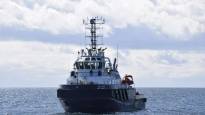The new findings confirm that ships belonging to Russia were moving in the area, which would have been useful in the preparation of the explosion of the gas pipeline.
Today, the Nordic broadcasting companies published new information about the movements of the ships of the Russian navy in the vicinity of the explosion site of the Nord Stream gas pipelines. The information was based on radio traffic and partly also on satellite images. Two vessels were near the northern blast site in June and one just days before the explosions on September 26 last year.
What should we think about the new Nord Stream data?
According to observations, ships of the Russian Navy, which have the ability to reconnoitre and support underwater special operations, have moved in the event area. The ships are in the Baltic Sea in their own operating area, so the environment and conditions are familiar to them.
Among the ships that moved in the area, the marine research vessel “Sibiryakov” is equipped with versatile equipment for underwater mapping and reconnaissance. According to the Nordic investigation, the ship moved close to the leak points of the gas pipelines for up to a day in mid-June.
In September, a few days before the explosions, the rescue tug “SB-123” is suitable, for example, for moving equipment and personnel, as well as lowering and raising it into the water.
SB-123 was located using radio traffic in the area northeast of Bornholm on 21 September. in the evening and 22.9. morning and afternoon.
On the same day, the Danish Information from the magazine Information (you will switch to another service) According to the report, the “SS-750” spotted on the spot is a vessel specialized in searching for wrecked submarines and rescuing the crew. It operates with a small AS-26 submarine of about 12 meters, which can operate independently underwater for several days.
These ships are not actual warships, but belong to the so-called auxiliary fleet of the Baltic Sea Fleet. Their movements may possibly be thought to attract less attention than if armed warships were on the move.
Different theories have been put forward about the Nord Stream strike. Russia has blamed them, for example, on Britain, on the other hand, there have also been reports that a pro-Ukrainian group carried out the attack.
How likely is it that there is a state actor involved?
There are many challenges and many opportunities for failure in this kind of operation at sea in autumn. This strongly suggests a governmental actor. First of all, there must be the ability to acquire and bring to the Baltic Sea a large amount of explosives that are suitable for underwater operations. There must also be a vessel and crew suitable for the conditions.
The operator must be able to locate the gas pipelines at the bottom of the sea and operate during the installation both on the surface and under water in the conditions of the autumn Baltic Sea. You have to be able to detonate either with a remote trigger or with riskier timing.
The person planning the attack must be able to evade the maritime and underwater surveillance of the states in the region and take into account the maritime traffic in the region.
You have to be able to do all these steps in secret, because being exposed at one step will probably lead to the failure of the whole operation.
What factors increase the credibility of the theory that it was Russia that would have been able to attack the gas pipelines?
There is not the slightest doubt that Russia would not have been able to blow up its own gas pipelines if it had wanted to.
In the Russian Baltic Sea, the fleet operates on its own home field, where it has been sailing for centuries. It has also had submarines for two hundred years.
The current Baltic Sea fleet has ships capable of supporting all phases of such an underwater destruction operation. The ships spotted at and near the explosion site fit that profile.
The actual targeting and destruction of the target was probably carried out by a special unit trained in underwater operations. In Russia, each of the four navies has such a force under the direction of the intelligence service GRU. In the Baltic Sea, the so-called underwater spetsnaz unit can be found in Parusnoje, Kaliningrad region. The 561st Maritime Intelligence Center operates there, and the distance from the base to the explosion site is about 300 kilometers.
Nordic broadcasting companies have asked the Russian embassy in Copenhagen about the ships, but have not received an answer from there.
Watch the third episode of the Shadow War series Arena.
You can discuss the topic until Friday 5.5. until 11 p.m.
